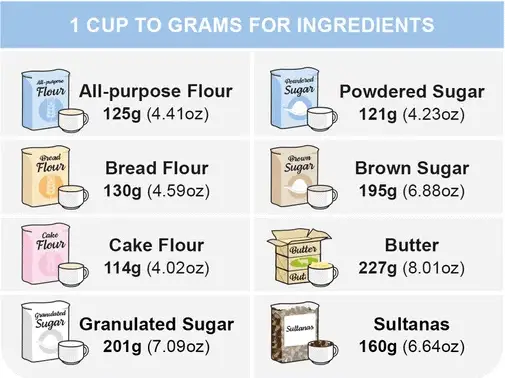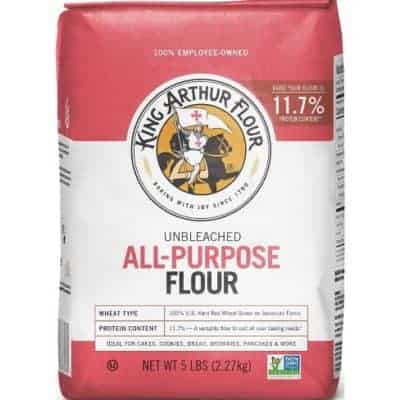Cooking and baking enthusiasts often look for essential guidelines and helpful tips that assist them in their kitchens. Keeping a particular recipe in front of you results in an easy and quick dish; however, specific aspects must be adequately measured and assessed before putting them in the assortment. In addition, some of the ingredients need to be accurately calculated for the recipe. Still, in most situations, the importance of measurement is disregarded and snubbed, creating a discrepancy in the recipe or producing an altered version of the standard recipe.

In baking, measuring cups and spoons are available in all utility stores, along with bakery essentials and utensils that help select the right ingredients. Suppose ingredients are not adequately measured before being added to the mixture. In that case, you may expect noticeable changes in the recipe, such as the mixture being too salty, sweet, thick, or full of one flavor. Equal flavor distribution is only possible if all the ingredients are generously mixed with a meticulous mix.
In our article, how many  grams are we converting group and cup to grams for various ingredients? In this article, we will analyze 350 grams of weight.
grams are we converting group and cup to grams for various ingredients? In this article, we will analyze 350 grams of weight.
How Many Cups are 350 grams?
To convert 350 grams to cups, you must know that 350 grams equals 1.48 cups (1 and 1/2 cups). However, 350 grams of different ingredients have different masses, such as:
| Product | Cup | Grams |
|---|---|---|
| Molasses | 1.00 | 350 |
| Buttermilk | 1.35 | 350 |
| Milk | 1.46 | 350 |
| Heavy Cream | 1.47 | 350 |
| Butter | 1.55 | 350 |
| Sour Cream/Yogurt | 1.59 | 350 |
| Corn Meal | 1.65 | 350 |
| Cream Cheese: | 1.65 | 350 |
| Vegetable Oil | 1.67 | 350 |
| Granulated Sugar | 1.84 | 350 |
| Chocolate Chips | 1.94 | 350 |
| Bread Flour | 2.33 | 350 |
| Brown Sugar | 2.33 | 350 |
| All-Purpose Flour | 2.50 | 350 |
| Cake Flour | 2.69 | 350 |
| Powdered Sugar | 2.69 | 350 |
| Cocoa Powder | 2.92 | 350 |
| Almond Flour | 3.50 | 350 |
| Oats, rolled | 3.50 | 350 |
| Walnuts, chopped | 3.50 | 350 |
Three hundred fifty grams is a relatively small amount, but it cannot be easily converted into cups accurately. Luckily, there are a few simple steps that you can follow to make this conversion.
The first step is to determine what type of substance you are converting from grams to cups. This can vary based on the food or liquid you are working with, such as water, sugar, honey, milk, flour, or butter.
Once you have determined the substance you want to convert from grams to cups, you can use a simple conversion ratio to complete the conversion. Generally, 1 cup will contain about the same weight as 350 grams of whatever substance you are working with. However, depending on the substance and its measurement, it may take slightly more or less than 350 grams to equal 1 cup.
To make this conversion accurate, it is essential to research and find reliable conversion ratios for your particular ingredient. You can find these online or in cookbooks and other resources specifically designed for cooking and baking.
Once you have determined your proper conversion ratio for grams to cups for your particular ingredient, multiply the number of grams by the ratio to get your final measurement in cups.
If you need help with any other conversions from grams to cups or more information about this topic, many online resources can help guide you. In addition to using reliable conversion ratios provided by cookbooks and other resources specifically designed for cooking and baking purposes, many online calculators can help make this process easier and more accurate.
Practical handbooks are available for baking and cooking experts to help them convert metric, imperial, and US cup measurement systems. Most home cooks avoid a particular measurement of an extra gram or two as it would not drastically affect the result. However, precise quantities should be necessary while working with more significant amounts. Inaccurate measurement can entirely unsettle the ratio and impair a formula. A round of estimation in terms of measurement is welcomed and accepted in cooking; however, proper ingredient measurements are needed in baking. If you are baking a recipe in larger quantities, purchase proper and clear-cut conversion utensils and tools or use online search engines to convert metric and imperial standards.
If a recipe requires 350 g of a particular ingredient, you can convert grams into the cup using the conversion table. For example, 10 g of something is 0.040 of a cup. Similarly, 150 g equals 0.6 cups, and 320 g equals 1.28 cups. According to the conversion table, 350 g of any ingredients can be converted using 1.4 cups.
Many reliable online websites are available that accurately deal with the conversion of measuring units. If you are a cook or a baker and uncertain about the standard measurement units, you can get help from online platforms. The conversion of cups to spoons, grams to cups, spoons to cups, and cups to grams is accessible to the cooks and bakers. Similarly, if you are confused about the number of cups for 350 g of self-rising flour, you must use about 2.5 cups.
How much is 350 grams of flour in cups?
To convert 350 grams of flour to cups, you must know that 1 cup of All-Purpose Flour equals 120 grams. Because of that, 350 grams of flour equals 2 3/4 cups. Usually, 350 grams of cake flour equals 2.69 cups.

Three hundred fifty grams of flour is roughly equivalent to 2 3/4 cups. If you use all-purpose flour, you must measure 2 3/4 cups to make the desired amount. However, if you use cake flour instead, 350 grams would roughly equal 2.69 cups.
There are several different ways to convert 350 grams of flour into cups. One option is to use a simple online conversion tool to quickly and easily convert your measurement. Another option is to use a kitchen scale or measuring cup set, which allows you to easily weigh or measure the correct amount of flour needed for your recipe.
Regardless of how you choose to do it, it is essential to be precise when measuring the amount of flour needed for your recipe. This will help ensure that your baked goods turn out as expected and help prevent any unwanted variations in texture or flavor. With some practice and attention to detail, converting grams of flour into cups will become easier and quicker, allowing you to create delicious baked goods every time more easily!
350 ml to cups
Around 1.5 cups equals 350ml. So you will need 1 and 1/5 US cups to measure 350ml in your recipes. However, if we want to calculate 350ml to cups accurately, it is 1.479 cups.
US cups differ slightly from UK cups; therefore, this factor must be considered before cooking and baking. In addition, certain technicalities must be addressed as such factors can change a recipe’s taste. Solids and liquids weigh contrarily because of their properties. For example, if flour is a primary formula ingredient, the conversion and precise measurement of solids and liquids must be figured out. The conversion and relation of grams and cups are simple but are based on primary computing.
The concept of density converter gradually becomes significant as it can dominate traditional ideas of weighing machines and hand calculators. Online tools that deal with conversion based on density formula mechanics are potent stimulants and guides in kitchen life and science. Traditional methods function by weighing machines that provide a precise result, but online tools operate on the binary system, taking multiple perspectives.
The US-based measurement system of one cup equals 2 to 36 mL, whereas the European standard is different as it gives about 250 mL. Consequently, cups are not considered a standard measurement unit. Measurements taken through cups are diverse and provide more than one result, as cups usually weigh volume. Grams, however, are a measuring unit that focuses on weight.
In cooking, we very often have 150 gr in recipes. So let us make a conversion:
How much are 150 grams in cups?
One hundred fifty grams are equal to 2/3 cup. It is because 1 cup has 230 grams.
Cooking Conversion Table
| US Metric | Cooking conversion |
|---|---|
| 1 cup = | 48 teaspoons |
| 1 cup = | 16 tablespoons |
| 1 gallon (gal) = | 4 quarts |
| 1 inch (in) = | 2.54 centimeters (cm) |
| 1 milliliter (ml) = | 1 cubic centimeter (cc) |
| 1 pint (pt) = | 2 cups |
| 1 quart (qt) = | 2 pints |
| 1 tablespoon (tbsp) = | 3 teaspoons (tsp) |
| 1/16 cup = | 1 tablespoon |
| 1/2 cup = | 8 tablespoons |
| 1/3 cup = | 5 tablespoons + 1 teaspoon |
| 1/4 cup = | 4 tablespoons |
| 1/6 cup = | 2 tablespoons + 2 teaspoons |
| 1/8 cup = | 2 tablespoons |
| 16 ounces (oz) = | 1 pound (lb) |
| 2/3 cup = | 10 tablespoons + 2 teaspoons |
| 3/4 cup = | 12 tablespoons |
| 3/8 cup = | 6 tablespoons |
| 4 cups = | 1 quart |
| 8 fluid ounces (fl oz) = | 1 cup |
Food recipes are only successful if the ingredients are prepared and consumed correctly regarding weight and volume. The essential equipment for measuring volume includes spoons, dry measuring containers, and liquid measuring containers, which are most common in every household, particularly for baking enthusiasts. Most bakers and cooks also use weighing scales to acquire accurate readings. However, to have a spot-on recipe, you also need to know the correct techniques for the ingredients. The methods vary for dry and liquid ingredients; therefore, purchasing an entire collection of weighing scales, tools, and equipment is not the only skill required in the kitchen.
In addition, not following the suggested quantities in the recipe can adversely affect the final product. For example, too much flour, butter, or salt may make your cookies crumbly and sweets or cakes unworthy of consumption. Similarly, if you add excessive sugar, the cookies break easily, and different cake layers collapse because they lack structural integrity.
To summarize, weighing ingredients before understanding the recipe is ideal for quality compliance. Quality requirements and recipe specifications go hand in hand; therefore, measuring them with extreme precision and accuracy guarantees cohesion, equal product distribution, and impeccable taste. Baking is considered a science; therefore, thorough and detailed precision is required while experimenting with science.
The situation is similar to performing practical testing in a lab where the ingredient measurements must be accurate to get the chemical reactions right. Learning and equating yourself with the art of size is an essential category of kitchen basics. Bakers need to be aware of the fundamentals of measuring the ingredients. Since baking is synonymous with science, you cannot add ingredients using standards such as a dollop, a pinch, or a handful. The perfect chewy chocolate chip cookie can only be achieved using reliable tools such as wing scale.
One more fact for the end:
350 ml to grams:
When we convert 350 ml to grams, we get 350 grams because 1 gram equals 1 ml.
How many cups are 150 grams?
One hundred fifty grams equals 2/3 cup of granulated sugar or butter. However, 150 grams equals 1 cup and 1/4 cup of all-purpose flour, Icing, or Powdered Sugar. Additionally, 150 grams equals 3/4 cup of brown sugar or ground Almonds. For liquids, 150 grams of milk equals 1/2 US cup or 3/4 US cup of water.
How many cups are 238 grams of Miralax powder?
There are around 2 cups or 8.34 ounces in 238 grams of Miralax powder.
How much is 235 ml of milk?
235 ml of milk equals around 1 cup or exactly 0.98 cups. Milk has a higher density than water, which affects its total volume.
Gram-to-cup Conversion Table
| Gram (water) | Cups (water) |
|---|---|
| How much is 5 g? | There are exactly 0.021133764 cups in 5 g of water. |
| How much is 10 g? | There are exactly 0.042267528 cups in 10 g of water. |
| How much is 15 g? | There are exactly 0.063401292 cups in 15 g of water. |
| How much is 20 g? | There are exactly 0.084535056 cups in 20 g of water. |
| How much is 25 g? | There are exactly 0.10566882 cups in 25 g of water. |
| How much is 30 g? | There are exactly 0.126802584 cups in 30 g of water. |
| How much is 35 g? | There are exactly 0.147936348 cups in 35 g of water. |
| How much is 40 g? | There are exactly 0.169070112 cups in 40 g of water. |
| How much is 45 g? | There are exactly 0.190203876 cups in 45 g of water. |
| How much is 50 g? | There are exactly 0.21133764 cups in 50 g of water. |
| How much is 55 g? | There are exactly 0.232471404 cups in 55 g of water. |
| How much is 60 g? | There are exactly 0.253605168 cups in 60 g of water. |
| How much is 65 g? | There are exactly 0.274738932 cups in 65 g of water. |
| How much is 70 g? | There are exactly 0.295872696 cups in 70 g of water. |
| How much is 75 g? | There are exactly 0.31700646 cups in 75 g of water. |
| How much is 80 g? | There are exactly 0.338140224 cups in 80 g of water. |
| How much is 85 g? | There are exactly 0.359273988 cups in 85 g of water. |
| How much is 90 g? | There are exactly 0.380407752 cups in 90 g of water. |
| How much is 95 g? | There are exactly 0.401541516 cups in 95 g of water. |
| How much is 100 g? | There are exactly 0.42267528 cups in 100 g of water. |
| How much is 105 g? | There are exactly 0.443809044 cups in 105 g of water. |
| How much is 110 g? | There are exactly 0.464942808 cups in 110 g of water. |
| How much is 115 g? | There are exactly 0.486076572 cups in 115 g of water. |
| How much is 120 g? | There are exactly 0.507210336 cups in 120 g of water. |
| How much is 125 g? | There are exactly 0.5283441 cups in 125 g of water. |
| How much is 130 g? | There are exactly 0.549477864 cups in 130 g of water. |
| How much is 135 g? | There are exactly 0.570611628 cups in 135 g of water. |
| How much is 140 g? | There are exactly 0.591745392 cups in 140 g of water. |
| How much is 145 g? | There are exactly 0.612879156 cups in 145 g of water. |
| How much is 150 g? | There are exactly 0.63401292 cups in 150 g of water. |
| How much is 155 g? | There are exactly 0.655146684 cups in 155 g of water. |
| How much is 160 g? | There are exactly 0.676280448 cups in 160 g of water. |
| How much is 165 g? | There are exactly 0.697414212 cups in 165 g of water. |
| How much is 170 g? | There are exactly 0.718547976 cups in 170 g of water. |
| How much is 175 g? | There are exactly 0.73968174 cups in 175 g of water. |
| How much is 180 g? | There are exactly 0.760815504 cups in 180 g of water. |
| How much is 185 g? | There are exactly 0.781949268 cups in 185 g of water. |
| How much is 190 g? | There are exactly 0.803083032 cups in 190 g of water. |
| How much is 195 g? | There are exactly 0.824216796 cups in 195 g of water. |
| How much is 200 g? | There are exactly 0.84535056 cups in 200 g of water. |
| How much is 205 g? | There are exactly 0.866484324 cups in 205 g of water. |
| How much is 210 g? | There are exactly 0.887618088 cups in 210 g of water. |
| How much is 215 g? | There are exactly 0.908751852 cups in 215 g of water. |
| How much is 220 g? | There are exactly 0.929885616 cups in 220 g of water. |
| How much is 225 g? | There are exactly 0.95101938 cups in 225 g of water. |
| How much is 230 g? | There are exactly 0.972153144 cups in 230 g of water. |
| How much is 235 g? | There are exactly 0.993286908 cups in 235 g of water. |
| How much is 240 g? | There are exactly 1.014420672 cups in 240 g of water. |
| How much is 245 g? | There are exactly 1.035554436 cups in 245 g of water. |
| How much is 250 g? | There are exactly 1.0566882 cups in 250 g of water. |
| How much is 255 g? | There are exactly 1.077821964 cups in 255 g of water. |
| How much is 260 g? | There are exactly 1.098955728 cups in 260 g of water. |
| How much is 265 g? | There are exactly 1.120089492 cups in 265 g of water. |
| How much is 270 g? | There are exactly 1.141223256 cups in 270 g of water. |
| How much is 275 g? | There are exactly 1.16235702 cups in 275 g of water. |
| How much is 280 g? | There are exactly 1.183490784 cups in 280 g of water. |
| How much is 285 g? | There are exactly 1.204624548 cups in 285 g of water. |
| How much is 290 g? | There are exactly 1.225758312 cups in 290 g of water. |
| How much is 295 g? | There are exactly 1.246892076 cups in 295 g of water. |
| How much is 300 g? | There are exactly 1.26802584 cups in 300 g of water. |
| How much is 305 g? | There are exactly 1.289159604 cups in 305 g of water. |
| How much is 310 g? | There are exactly 1.310293368 cups in 310 g of water. |
| How much is 315 g? | There are exactly 1.331427132 cups in 315 g of water. |
| How much is 320 g? | There are exactly 1.352560896 cups in 320 g of water. |
| How much is 325 g? | There are exactly 1.37369466 cups in 325 g of water. |
| How much is 330 g? | There are exactly 1.394828424 cups in 330 g of water. |
| How much is 335 g? | There are exactly 1.415962188 cups in 335 g of water. |
| How much is 340 g? | There are exactly 1.437095952 cups in 340 g of water. |
| How much is 345 g? | There are exactly 1.458229716 cups in 345 g of water. |
| How much is 350 g? | There are exactly 1.47936348 cups in 350 g of water. |
| How much is 355 g? | There are exactly 1.500497244 cups in 355 g of water. |
| How much is 360 g? | There are exactly 1.521631008 cups in 360 g of water. |
| How much is 365 g? | There are exactly 1.542764772 cups in 365 g of water. |
| How much is 370 g? | There are exactly 1.563898536 cups in 370 g of water. |
| How much is 375 g? | There are exactly 1.5850323 cups in 375 g of water. |
| How much is 380 g? | There are exactly 1.606166064 cups in 380 g of water. |
| How much is 385 g? | There are exactly 1.627299828 cups in 385 g of water. |
| How much is 390 g? | There are exactly 1.648433592 cups in 390 g of water. |
| How much is 395 g? | There are exactly 1.669567356 cups in 395 g of water. |
| How much is 400 g? | There are exactly 1.69070112 cups in 400 g of water. |
| How much is 405 g? | There are exactly 1.711834884 cups in 405 g of water. |
| How much is 410 g? | There are exactly 1.732968648 cups in 410 g of water. |
| How much is 415 g? | There are exactly 1.754102412 cups in 415 g of water. |
| How much is 420 g? | There are exactly 1.775236176 cups in 420 g of water. |
| How much is 425 g? | There are exactly 1.79636994 cups in 425 g of water. |
| How much is 430 g? | There are exactly 1.817503704 cups in 430 g of water. |
| How much is 435 g? | There are exactly 1.838637468 cups in 435 g of water. |
| How much is 440 g? | There are exactly 1.859771232 cups in 440 g of water. |
| How much is 445 g? | There are exactly 1.880904996 cups in 445 g of water. |
| How much is 450 g? | There are exactly 1.90203876 cups in 450 g of water. |
| How much is 455 g? | There are exactly 1.923172524 cups in 455 g of water. |
| How much is 460 g? | There are exactly 1.944306288 cups in 460 g of water. |
| How much is 465 g? | There are exactly 1.965440052 cups in 465 g of water. |
| How much is 470 g? | There are exactly 1.986573816 cups in 470 g of water. |
| How much is 475 g? | There are exactly 2.00770758 cups in 475 g of water. |
| How much is 480 g? | There are exactly 2.028841344 cups in 480 g of water. |
| How much is 485 g? | There are exactly 2.049975108 cups in 485 g of water. |
| How much is 490 g? | There are exactly 2.071108872 cups in 490 g of water. |
| How much is 495 g? | There are exactly 2.092242636 cups in 495 g of water. |
| How much is 500 g? | There are exactly 2.1133764 cups in 500 g of water. |
- Facebook Ads to Get Followers! - December 27, 2024
- ClickUp vs. Slack - December 20, 2024
- Mastering E-Commerce Analytics: A Blueprint for Success





